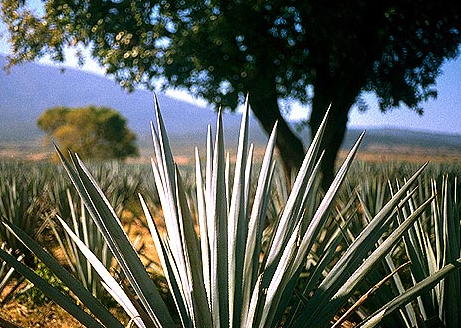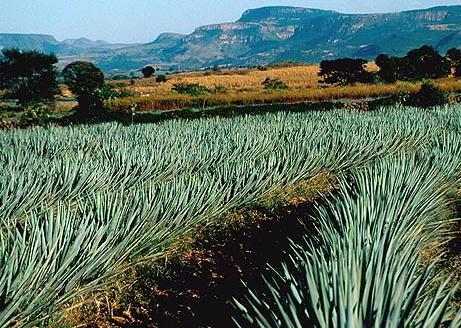Well, for openers, a respite from the summer heat and humidity. It is sweltering here in Sayulita, a small fishing village just north of Puerto Vallarta, and the desire for some moderate temps and cool nights gave impetus to travel north to Tepic, the capital city of the Mexican state of Nayarit. At 3,000 feet altitude and somewhat inland, it offers a drier and cooler clime than down here at sea level.
I and my wife, Shelley, had been told that Tepic was a beautiful city, the "Jewel of Nayarit" no less, and that we would not see many gringos there. On that second point, they were wrong; we didn't see ANY gringos there at all. No gringos means you better have your Spanish cranked up because nobody there speaks English. The first point-the "jewel" part-remains to be seen.
 |
 |
| Closeup of the blue agave plant, mother of tequila. The leaves are extremely sharp and can cause almost as much damage as the tequila itself. | Fields of the blue agave cover much of the available arable land in the Mexican states of Nayarit and Jalisco. |
Heading north out of Sayulita on México Hwy. 200, we passed fields of pineapple and banana and mango interspersed between miles of jungle. Rising steadily through the mountains, we emerged into higher plateaus supporting sugar cane plantations and large cultivations of the plant that put the "Carumba!" in Mexico: the blue agave, Blessed Saint of mescal and tequila. Entire books have been written about the plant and its many uses, so suffice it for me to say this... steer clear of the leaves. They are about three to four feet long at maturity, have EXTREMELY sharp needle-like tips and vicious razor-like edges. Put the agave plant at Number 1 on your list of 10 Worst Places to Land When Skydiving, ahead of Rottweiler Farm and a Hell's Angels Gun Swap and Beer Bust.
We arrived in Tepic during the lunch hour and in the middle of some major traffic. Through the snarled traffic and interminable traffic signals we managed to find a very nice hotel right on the main downtown plaza, or zocolo, called the Hotel Fray Junipero Serra. The Lonely Planet suggests that a double room will set us back $55 US, but we shelled out $75 US during the low season. One outstanding point in favor of this hotel is, unlike anything else we found in the busy downtown area, it has underground parking. It's nearly impossible to find parking around the zocolo, so this was the deciding factor for us.
| The main plaza, or zocolo, seen from the second floor restaurant La Gloria. Typical of Mexican cities and pueblos alike, the zocolo is the central area for citizens to mingle, socialize, relax, and perhaps flirt a little. Although busy during the daytime, it's the nighttime that brings the crowds out. | The zocolo as seen from our hotel window at dusk. As the lights come on more people begin to arrive for the nightly tradition of walking the plaza. |
The area surrounding the zocolo for many blocks in every direction consists of shops selling everything under the sun at very reasonable prices. However, at least half of the shops sold shoes. The Tepiqueños have some kind of shoe fetish, I swear. Even the ice cream store offered a selection of footwear. Imelda Marcos would have been crowned Goddess For Life had she lived here.
| As if to underscore the shoe thing, there are shoe shine stands set up on every available stretch of sidewalk around the zocolo. Even 5 year old caballeros sit on the stands and get their snakeskin cowboy boots buffed to a shine visible from space... just like dad's. Everywhere we went, garbed in our home town flip-flops, our feet got stares as if we were poor, starving aboriginals who couldn't afford decent footwear. I finally relented to peer pressure and put on my Nike running shoes, but Shelley just kept on a flip floppin' along with her patented Texas swagger. |
| The location of the hotel next to the zocolo places it about a sand wedge from the oldest cathedral in the area: The Cathedral of the Purisima Concepción de María. Construction began in 1750 and was completed in 1885. It is probably an extraordinary church to see inside, but the doors were locked and entrance prohibited on our Saturday attempt. Sunday morning the bells begin pealing at 0700 hours sharp with an eardrum crushing, mind melting cacophony of gonging. Stick your head in a 55-gallon drum and have three of your friends wail away on it with baseball bats and you will get an idea of the Immaculate Conception Wakeup Call, Tepic style. We considered going in on Sunday during mass, but thought that might be unwise as my blasphemous remarks vis-à-vis the morning bells might bring down His Wrath from above, destroying this important historical edifice. We passed on the church and went on to our next goal: the museums. |
Travelogues on Tepic describe the museums as "must see." No mention was made of the fact that the museums are not open on Sundays, putting a crimp in our plans to view native arts and crafts as well as the remnants of local antiquity. So, the "must see" museums, which probably are worth the visit, will have to wait for another trip.
Sunday morning we decided to leave Tepic for points eastward, specifically the ancient ruins of Los Toriles just outside of Ixtlán del Rio. It is possible to get to Ixtlán del Rio via the much faster 4-lane toll road (Highway 15) heading toward Guadalajara. But what challenge is that? We opted for the two-lane free road, and as our reward for doing so, tripled our travel time to Los Toriles behind three 18-wheelers with no passing opportunities until you hit France. The toll road, in hindsight, might be the better choice.
Perhaps more important is the question, "Are the ruins worth the trip in the first place?" Tough call, in our opinion.
We were greeted at the site by a kindly, older gentleman dressed in an impressive security uniform and sporting, among other things, a 9mm Glock on his hip. This is odd for two reasons. First, guns are so tightly controlled in México that only the army and the State Police pack heat. To see anyone else with a weapon is unusual. Secondly, as we were to discover shortly, every "relic" at Los Toriles is a replica. While somewhat informative, they are completely worthless; all of the real stuff is in Guadalajara or Tepic. So, what, exactly, is he guarding? The mystery remains shrouded in secrecy to this day.
He did, however, have a wealth of knowledge about the place and shared it with me on a 20 minute tour of the museum portion of the site. (His incredibly bad breath forced Shelley to abandon the tour in its formative stages.) The area has yielded artifacts indicating that the area was populated as early as 3,500 years ago. It goes without saying that they lived simple lives with a profound respect for natural forces that they didn't understand. They built a number of stone buildings and burial chambers, the remains of which are there to view and walk amongst. They did not develop a society capable of erecting awe inspiring temples a la the Aztec and Maya, but they did manage to maintain a civilization that spanned many thousands of years, no small feat. The excavated ruins are modest and consist mainly of foundations with the first couple of feet of columns rising upward, requiring some imagination to visualize the completed buildings. There are no pyramids of any kind there. Nor were there any sacrificial altars where high priests wearing huge feathered headdresses ripped still-beating hearts from unfortunate souls, making Saturday nights pretty dull there, I suspect.
| The ruins of Los Toriles. Perhaps the Toltecs had visions of greatness but could only afford to build mini-pyramids. | Larger structure, perhaps the home of a person of importance. | Another structure of unknown use. Shelley poses in front with an umbrella for protection from the sun. |
There is one other interesting thing to note about Los Toriles: the ground upon which the ruins sit is home to thousands of fire ant colonies. If you stand still long enough to take a photograph you will find yourself in short order doing the Macarena in an attempt to rid yourself of the little buggers. Good luck... they are tenacious.
After perusing the ruins for an hour or so we decided to head back for Sayulita to recap the adventure poolside with margos, per Mexican law. As for Tepic being a "jewel," we honestly didn't see enough of it to make an informed call on that point. It doesn't seem especially attractive driving through, but we will reserve judgment for now as saw very little of the town, other than the zocolo area. We missed the museums (closed Sundays) and the cathedral (closed Saturdays) so we have some goals yet to achieve there.